QuestionQUESTION:
Hi, two weeks ago my boy friend, John adopted a 10yr. old lab mix,(possibly german sheperd or aussie) from a placement group, I am emailing because he does not have a computer. his name is Jake he is 87lbs, he has spent the last 7 yrs. cooped up in a 20x20 run. He was never let off leash and had not been exposed to other animals for over 5 yrs. John has 2 dogs, Zoe 12 yrs sweet mellow lab /golden retriever mix and Cub 6 yrs high energy athletic, confident, big border collie, I also have a border collie. We are very commited to our dogs and take them for daily beach walks and hikes, off leash. We where told that Jake was very mellow and friendly and not aggressive but just "protective" and "bolts when gets of leash". Well he is wonderful with humans and John has been able to let him off leash alone without the other dogs at a quiet deserted beach and he even comes when he is called, (may be because he knows he is not going back to jail? :) he is very happy to be running free and going on adventures. The problem is he is Dog aggressive and John has kept him separated from his other dogs in a back room or in a separate pasture area. John has been taking him to work every day, believing they are bonding and also because he needs to clean up and secure the pasture better before he leaves him unattended. I worry he is not going to want to share john after spending all this time alone with him and start to protect him from the other dogs as my rescued border collie used too with me. He growls & snaps and barks and lunges at other dogs and chases cats, birds you name it. John is very calm, kind and patient and wishes to work with him to properly integrate him into our pac and world, our dream is that he can join our happy, healthy clan and live out his golden years at the beach and in the mountains with us. Because he is older and has not been socialized we are wondering if we are asking to much? We also have discoverd he is not potty trained as he was never allowed inside. He lived a loney and isolated life and we wish to give him a happier story. any advise will be much appreciated. Terra
ANSWER: John is to be congratulated for giving a new life to this dog who would have been passed up (because of age) by most other people. However, this dog is far too old to expect him to accept other dogs without some serious, long term behavior modification. His total lack of socialization to other dogs is a strong indication that this might not be possible. Lack of socialization creates fear and fear creates defensive reaction (aggression). The other dogs will be unable to cognitively identify this dog's response to them and that will make the situation much worse (and possibly dangerous). This is a "worst case" scenario. His chasing cats and birds is a non issue, that's a prey response and you cannot extinguish it...CANNOT.
I suggest you and John take all his dogs out together on neutral territory (OFF his property) with all dogs on leash. You manage the other two while John takes the newbie. Approach John and Newbie and have John observe Newbie's body language. When Newbie responds with lunging, have John walk in a tight circle with Newbie (repeatedly) until Newbie visibly calms, then have John approach you again. Repeat this until Newbie is much calmer (this may take a while, perhaps it won't happen, perhaps it won't happen during the first encounter, the second, the third, etc., you must keep trying.) Once Newbie is calmer and his body language is not alarming John's other dogs (you are to ignore their response, just stand there and do nothing), walk all three dogs parallel with one another for about five minutes. Repeat this exercise again (once Newbie has calmed and is able to walk alongside) several times over the course of a few days, and then take it onto a fenced area on John's property and repeat. I'm assuming both of John's other dogs will NOT respond with active dog aggression; if either will, this can't be done in this manner and the other dog must also be addressed: for this you will need an observer, a certified applied animal behaviorist. IF, however, John's other dogs are able to maintain their cool (following Newbie's visible calming and parallel walking), you are ready to put Newbie on long, strong training leash while allowing the other dogs off leash (only if they are able to respond to commands like "leave it" and recall to you). The aim here is to help John's other dogs to observe Newbie is NOT a threat (because Newbie is calmer and learning to accept them) and to help Newbie to observe the other dogs non-threatening interaction with him and John and you while he himself is in a calm, non-defensive state. If you are able to repeat this experience over the course of ten to twelve trials, you are ready to allow Newbie far more freedom in interaction (but still on very very long restraint, clothesline would be good). In this manner, you can slowly allow Newbie more and more "freedom" to develop his relationship with the other two dogs, providing you see no overt display of aggression between/among them. This is all very tricky and possibly risky (should a fight erupt). Bring a VERY LOUD noise maker (a portable air horn) in the event a fight does erupt and drag the dogs apart by their hind legs. I won't say this can't be done, because I've done it; but it's not easy.
Regarding the house training issue, you CAN teach an old dog new tricks. Newbie really wants to please. John should reward/praise every appropriate elimination outdoors, making sure to anticipate the dog's need to eliminate in a fair manner. Showing displeasure toward the "accident" itself, NOT THE DOG, will communicate to the dog that the presence of urine/stool INDOORS is not well tolerated by John (but the dog will make no connection to himself so long as John does not direct it AT HIM). The dog will very quickly learn to eliminate outdoors but he can't be faulted for accidents, given his abusive and neglected past.
Please repost with any results and further questions.
---------- FOLLOW-UP ----------
QUESTION: Thank you for all the brillant advice I can't wait to try it out on neutral ground. Now when the "newbie" Jake is in this aggressive frenzy (on leash) he is jumping around like a crazy man and will turn towards John with snapping jaws it is quite scary looking. We where wondering if it would be a good idea to put a muzzle on him? At home the dogs will sniff each other under the door and when John opens the door he does not get aggressive he just looks at the other two. John once put him in the pasture next to his yard and the dogs where able to sniff each other through the fence and run back and forth along the fence line, he said there was no aggression, only the one time when John tried to take them for a walk togther on leash and another when he came to visit me and my dog we tried a leashed walk at a distance and when we got to close he freaked, so we pulled back. John plans on cleaning up the wood pile and fencing material (in the pasture) that could be a danger to Jake's safety this week so that he can let them get to know each other through the fence. We both have had animals all our lives and we both can keep a cool head and work through this, we embrace the challenge and know how rewarding it will be if we can rehabilitate this sweet animal. Thank you so much, it is really great learning from you and Turid Rugaas and others, who do such great work the beloved dog-god. Truelly grateful, Terra
AnswerThe leash is, obviously, physical restraint. For a dog well accustomed to a leash (and Jake most likely is not) it is also psychological restraint. In Jake's case, he's reacting to the physical restraint; his gymnastics (and jaw snapping, out of over excitement, I don't construe this as aggression) are the result of his over the top excitement (driven by the leash restraint, at least in part.) His introduction to the other two dogs seems fine (when door is opened briefly and along fence lines) and Jake may NOT prove a problem OFF LEASH. I totally understand why John is concerned but his concern may be contributing to Jake's anxiety!! SO....YOU hold Jake's leash and let JOHN hold the other two dogs. DO NOT REACT to Jake's hyper excitement; walk in tight circles, first left, then right, until Jake calms visibly. As I said earlier, this may take some time (or it might work the first time you do it). Walking in circles is an old trick to force the dog's cognitive faculties to detach from whatever emotion driven behavior the dog is in. Try it yourself! The next time you feel upset, walk in a circle, first right then left; this actually changes the brain's response to stress. Let's see if Jake can learn to accept the other dogs while HE is on leash. However, given your description, I would like you to keep the other dogs on leash while letting Jake out on long, strong restraint (after the initial exercise has produced a calm dog that can walk parallel with the others). Since Jake is basically unaccustomed to this restraint, he will be VERY AWARE that he is still restrained (unlike most dogs who, accustomed to the normal length of the lead, think themselves "free" when on very long lead.) A muzzle is totally out of the question. Dogs know that they are restricted by the muzzle and their reaction can actually be accentuated, causing much more trouble when the muzzle is removed. In Jake's case, you can't even use a head collar. From your further description, it appears to me that Jake will be able to integrate into John's pack.

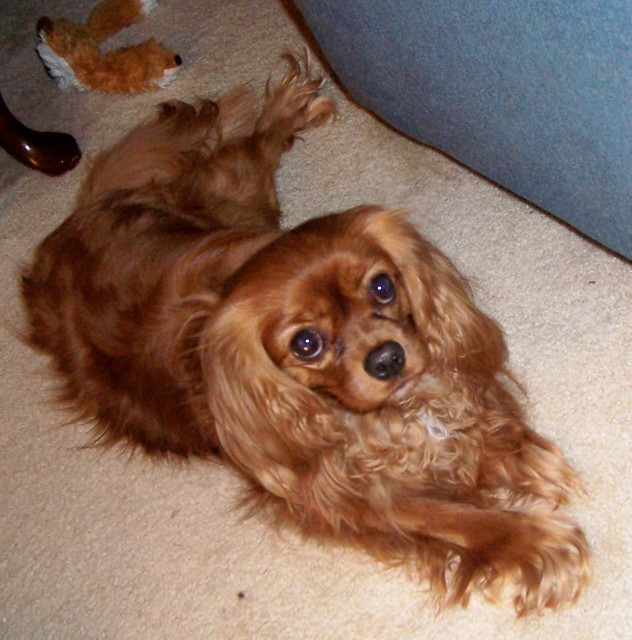 Dog light and shadow chasing
Question
Jenni
My 3 year old Cavalier King Charles Span
Dog light and shadow chasing
Question
Jenni
My 3 year old Cavalier King Charles Span
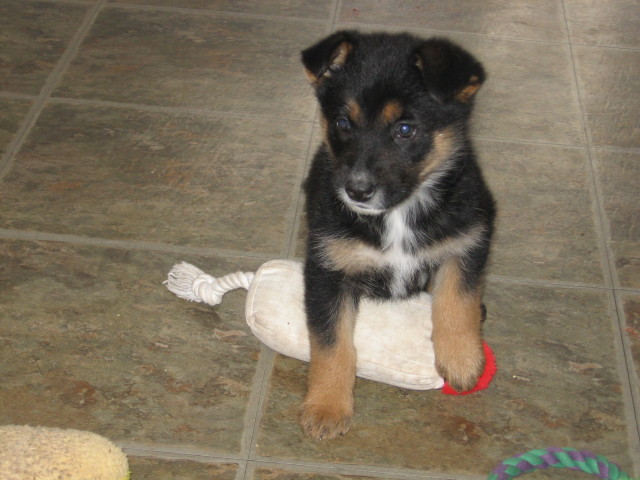 puppy problems
QuestionQUESTION: I am the proud owner of 2 german shep
puppy problems
QuestionQUESTION: I am the proud owner of 2 german shep
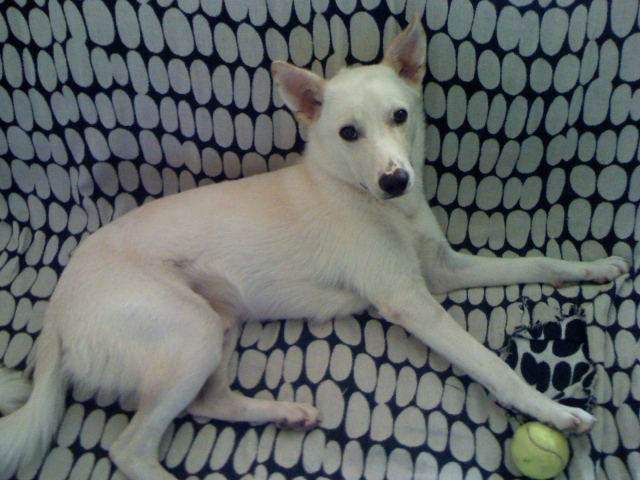 Dog walking problems
Question
Snickers
I have been trying to train my dog SN
Dog walking problems
Question
Snickers
I have been trying to train my dog SN
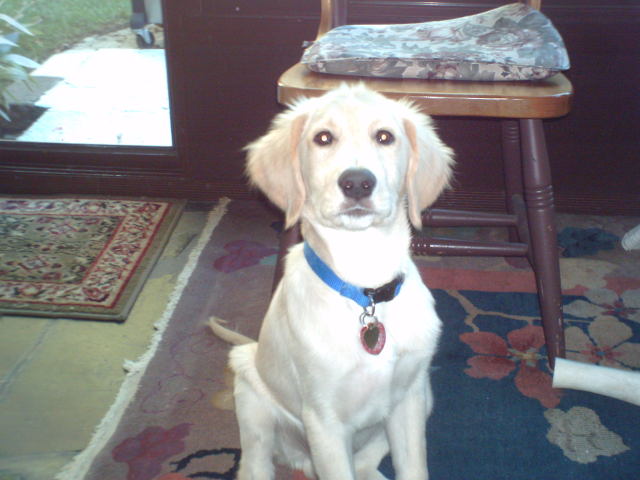 my 7 month old golden changed for the worse
QuestionRiley at 6 months
QUESTION: I got a gold
my 7 month old golden changed for the worse
QuestionRiley at 6 months
QUESTION: I got a gold
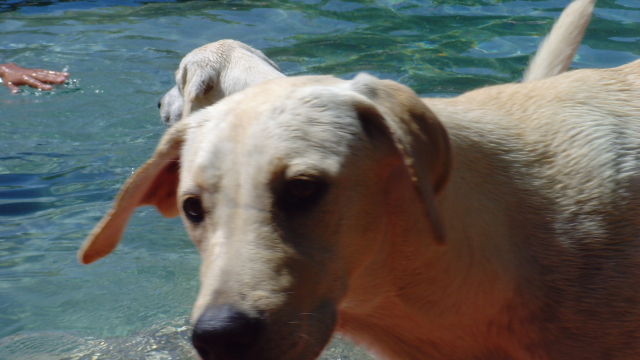 Psychological trauma
Question
Izzy
I recently took my 1 year old dog to a fr
Psychological trauma
Question
Izzy
I recently took my 1 year old dog to a fr